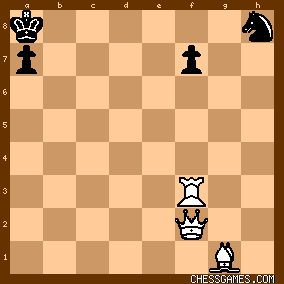Gilmoy

- I Fork Myself, Or Let The Fork Happen
Canonical self-fork:
1. Alice moves a piece where it can be taken by a pawn.
2. Bob doesn't take it.
3. Alice moves a 2nd piece where it is forked by that same pawn.
4. Bob can't take them both.
Partial self-fork:
1.5 Bob moves a pawn to attack Alice's piece.
2.5 Alice doesn't retreat the piece; goto 3.
|
|
13 games, 1950-2015 - It's Still Mutual Threat!
Pattern triggers:
1. R2-D2 attacks Chewbacca's Q (and not with its own Q).2. Chewbacca counterattacks R2-D2's Q (and not using his own Q). This indirectly offers to trade Qs (without either side playing QxQ). Pattern payoff:
3. R2-D2's Q makes any desperado capture, regardless of self-peril, because Chewbacca's Q is still under attack. It's <still> mutual threat!
|
|
12 games, 1857-2014 - Puns I've Submitted
8 games, 1864-2015 - The Double-Double, or Fork of Weight 2
Pattern elements:
1. 1st line-mover (usually an R) attacks 1st target with weight 1, defended once. (The target can be an empty square.)2. 2nd line-mover (usually a B) attacks 2nd target with weight 1, defended once. 3. Move your Q onto the intersection of #1 and #2. This reduces to a simple fork, as if the R+B + both defenders were not present.

click for larger view
As the Q must generally be behind the R and in front of the B, this further necessitates: 4. an R lift
5. a B thing (develop + retreat) or fianchetto
Astronomy: Epsilon Lyrae, an easy binocular/spotter scope double (208.2"), of which each "star" is itself a tight double (~2.5"). Splitting all 4 stars simultaneously (in the same field) is a canonical test of your optics and collimation.
|
|
9 games, 1923-2016 - The Right of Refusal Trade
Pattern elements:
1. Alice discovers or forks Bob's piece of higher value (usually Bob's Q), often as a zwieschenzug.2. Bob looks deeper, sees enough compensation, and takes the piece instead of retreating his Q. Bob trades Q for 2 pieces + dynamic factors, and wins.
|
|
23 games, 1899-2016 - The Swinging Gate: Push That P to 6 or 3!
Pattern triggers:
0. enemy Kh8/Kh7 (so that the Q entry is with check)
1. a P on 6 or 3 (usually h)
2. an R behind it (for discovered check)
3. a double on g7/g2 (so that the P will be defended)
click for larger viewKey move: Q(g7,g2)+ for a pawn double-check. This converts to a triangle mate at h8/h1, with the protected-P providing the role of the diagonal-mover, instead of the usual (B,Q)f6/f3. Benefit: Double-check trumps any overprotection of g7/g2. Mnemonic: Push that P to 6 or 3!
|
|
22 games, 1909-2015
|
|
| SEARCH ENTIRE GAME COLLECTION DATABASE |
use these two forms to locate other game collections in the database

|
|



